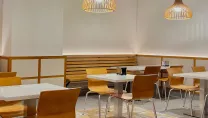Green walls have become a standout feature and tool to in createing dynamic, healthy, and aesthetically pleasing workspaces. Together with functional office furniture solutions. They transform a space, promoting a sense of well-being, while offering practical benefits such as air purification and sound insulation.
Before selecting a green wall, you should consider if a living plant wall or an artificial one is best for your organisation. Both options have their own unique advantages, and choosing the right solution depends on factors such as budget, maintenance capacity, and aesthetic goals. In this blog, we’ll explore the key differences between living and artificial green walls, helping you decide which is the best fit for your organisation.
What is a Living Plant Wall?
A living plant wall, also known as a vertical garden, is a structure featuring real plants that are grown vertically. These walls can be composed of a variety of plant species, supported by either soil or hydroponic systems (growing plants without soil), and are maintained with built-in irrigation systems to keep them in good health.
Key components of a living plant wall include:
- Plant varieties: A mixture of greenery suited for indoor or outdoor environments, selected based on light levels and climate control within the office.
- Soil or hydroponic systems: These provide the necessary nutrients for the plants to grow vertically.
- Irrigation and drainage systems: These keep the plants hydrated and ensure excess water is removed.
Living plant walls can enhance the indoor environments and office spaces by improving air quality and increasing humidity. By filtering pollutants, these natural systems contribute to a healthier workplace. Also, the organic look of a living plant wall brings the outside world into the office, promoting a sense of calm and well-being for teams.
What is an Artificial Green Wall?
An artificial green wall consists of synthetic plants that mimic the appearance of real greenery. These are installed in a vertical structure made of high-quality faux foliage, often mounted on panels for ease of placement. Despite their synthetic nature, artificial green walls closely resemble natural greenery and offer a consistent, polished look year-round.
Key components of an artificial green wall include:
- High-quality faux foliage: Designed to mimic real plants with realistic textures and colours.
- Backing materials: Lightweight but sturdy materials like plastic or metal for easy installation.
- Installation methods: Artificial panels can be attached to walls with minimal fuss, making them quick to install.
Artificial green walls are celebrated for their low-maintenance requirements and versatility. Unlike living plant walls, they don’t require water, sunlight, or pruning, and their appearance remains uniform over time. This makes them ideal for organisations that want the visual appeal of a green wall without the upkeep.
Key Differences Between Living and Artificial Green Walls
When deciding between living and artificial green walls, understanding the core differences will help you make the best decision for your organisation.
- Maintenance and Care:
- Living Plant Walls: Require regular attention, including watering, pruning, and monitoring of plant health. Depending on the size of the installation, this could mean needing dedicated maintenance personnel or services.
- Artificial Green Walls: Need minimal upkeep, requiring only occasional cleaning to keep them dust-free and looking fresh.
- Cost Considerations:
- Living Plant Walls: Have a higher initial cost due to installation complexity, plant selection, and the need for ongoing maintenance. However, the long-term benefits, particularly around air quality and employee well-being, could outweighs these expenses. Living proof (pardon the pun) you are investing in your people and teams health and well being!
- Artificial Green Walls: Typically come with a lower upfront cost. While high-quality artificial walls can be expensive, they involve little to no maintenance expenses over time, making them a cost-effective solution for many organisations.
- Environmental Impact:
- Living Plant Walls: Positively impact the environment by naturally purifying air, reducing CO2 levels, and contributing to biodiversity, especially in urban settings.
- Artificial Green Walls: Although they do not offer the natural benefits of real plants, they may have a smaller environmental footprint in terms of water and energy consumption for maintenance. They are also built for longevity, meaning you won’t need to replace them regularly if ever.
- Aesthetic and Atmosphere:
- Living Plant Walls: Provide a dynamic and ever-changing natural aesthetic. The organic nature of the plants contributes to a feeling of being connected to nature, which can boost team members' well-being and productivity.
- Artificial Green Walls: Offer a stable and consistent appearance that can be tailored to specific design preferences. They’re perfect for organisations that want to maintain a certain look without worrying about plant health or seasonal changes.
- Installation and Flexibility
- Living Plant Walls: Require a more complex installation process, including the setup of irrigation systems and infrastructure capable of supporting plant growth. Professional installation is often needed to ensure the plants thrive.
- Artificial Green Walls: Easier and quicker to install, with flexible placement options that don’t depend on light or water sources. They can be installed almost anywhere in the office, making them a highly adaptable design choice.

Benefits of Living Plant Walls
Living plant walls offer numerous long-term benefits for organisations that prioritise environmental impact and employee well-being:
- Improved indoor air quality: Through natural processes such as photosynthesis, living plant walls help filter harmful pollutants and increase oxygen levels.
- Enhanced well-being and productivity: Research has shown that natural elements in the workplace can boost creativity, reduce stress, and increase productivity.
- Sustainability: For organisations aiming to meet sustainability goals, living plant walls provide a tangible way to contribute to greener practices.
Benefits of Artificial Green Walls
For organisations looking for a cost-effective, low-maintenance solution, artificial green walls have their own set of advantages:
- Cost-effective and quick: With no need for irrigation or specialised care, artificial walls are an affordable and quickly installed solution for long-term use.
- Consistent appearance: Artificial green walls maintain their appearance year-round, making them ideal for spaces that require a consistent design.
- Versatility: These walls can be installed in spaces where living plants wouldn’t thrive, such as areas with low light or fluctuating temperatures.
Choosing the Right Green Wall for Your Organisation
When deciding between a living or artificial green wall, consider the following factors:
- Budget: Can you invest in the ongoing maintenance of a living plant wall, or would a one-time installation of an artificial wall suit your financial needs better?
- Maintenance capacity: Does your organisation have the resources to care for living plants, or is minimal upkeep more practical?
- Aesthetic preferences: Are you looking for a natural, ever-changing design, or would a consistent, clean look better suit your space?
- Long-term goals: Consider how your office design might evolve in the future and whether flexibility or sustainability is a higher priority.priority. Select a solution that offers your organisation maximum longevity.
Conclusion
Living and artificial green walls each offer distinct benefits, from enhancing indoor air quality and well-being to providing a cost-effective, low-maintenance design solution. By carefully assessing your organisation's needs, budget, and long-term goals, you can determine which green wall solution will best enhance your workplace environment. Whether it’s the natural vibrancy of a living plant wall or the ease of an artificial one, both options can make a significant impact on your workplace design.
Ready to explore the perfect green wall for your organisation? click here to contact our Workplace Design team to see how green walls can transform your workspace!





